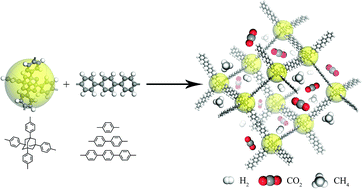Synthesis of thermochemically stable tetraphenyladamantane-based microporous polymers as gas storage materials†
Abstract
In view of environmental pollution control and purification of natural gases, developing ideal porous materials for small gas molecule (hydrogen, methane and carbon dioxide) capture is an important, pressing challenge. Accordingly, herein, three microporous organic polymers (MOP-Ad) have been synthesized by Suzuki coupling polymerization of 1,3,5,7-tetrakis(4-bromophenyl)adamantane “knots” with three phenylboronic acid-type “rods”. Gas adsorption studies of the MOP-Ad materials demonstrated their permanent porosity and good gas storage capabilities (1.07 wt% H2 at 77.3 K and 1.13 bar, 10.3 wt% CO2 and 2.4 wt% CH4 at 273.1 K and 1.13 bar), as well as moderate CO2/CH4 adsorption selectivity. Moreover, high thermal stability (up to 520 °C) and remarkable chemical resistance to strong acids and bases were found in these polymers, making them suitable candidates as gas storage materials in harsh chemical environments.



 Please wait while we load your content...
Please wait while we load your content...